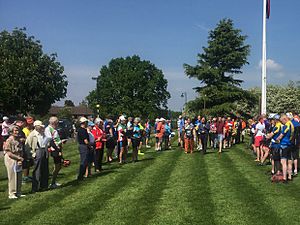Cyclists War Memorial facts for kids
The Cyclists War Memorial is a monument built to remember soldiers who died in wars. It stands on the village green in Meriden, West Midlands, England. This village is located between the cities of Coventry and Birmingham. For a long time, Meriden was thought to be the exact geographical centre of England.
This national memorial was created in 1920. It was built to honor cyclists who were killed during the First World War. One of the first British soldiers to die in that war was Private John Parr, who was a reconnaissance cyclist. Later, in 1963, a bronze plaque was added to the memorial. This plaque remembers cyclists who died in the Second World War.
Contents
Why Was It Built?
A group was formed in November 1919 to plan a national war memorial for cyclists. This group was led by W. G. Howard Gritten, a politician who was sometimes called the "cyclists' MP." The Lord Chancellor, the 1st Earl of Birkenhead, was the president of the committee.
About £1,100 was raised through donations from the public. A special way they raised money was by selling the bicycle of the Prince of Wales, who later became King Edward VIII. His Rudge-Whitworth bicycle was sold at an auction for £100.
How It Looks
The memorial is a tall, pointed stone pillar called an obelisk. It is made of grey granite stone from Cornwall. The obelisk is about 30 ft (9.1 m) (9 meters) high and weighs around 32 t (31 long tons; 35 short tons) (32,000 kilograms).
It stands on a square base that is about 7.5 ft (2.3 m) (2.3 meters) wide. On the front of this base, there is a special panel with words written in gold. The words say: "TO THE / LASTING MEMORY / OF THOSE / CYCLISTS / WHO DIED IN THE / GREAT WAR 1914 - 1919".
The memorial was designed to be simple. It does not have many cycling symbols. It was placed in the "heart of England" so that people from all over the country could visit it easily.
Its History
The memorial was built in 1920 by stonemasons J White and Sons from Yardley, Birmingham. It was officially revealed on May 21, 1921. The Earl of Birkenhead unveiled it, and Rev. Bourchier dedicated it.
About 20,000 people attended the ceremony, including thousands of cyclists. Every year, around the anniversary of the unveiling, the Cyclists' Touring Club holds a special memorial service in May.
In 1963, the memorial was rededicated. This is when the plaque for the Second World War was added. This plaque reads: "IN REMEMBRANCE / OF THOSE / CYCLISTS / WHO GAVE THEIR LIVES / IN WORLD WAR II / 1939 - 1945".
In 2001, the memorial became a Grade II listed building. This means it is an important historical building that needs to be protected. A second plaque was added in 2013. This plaque remembers all cyclists who fought and died for their country. It was dedicated at the remembrance service in May 2014.
Near the Cyclists War Memorial, there is another old stone monument. This monument is also a Grade II listed building. By tradition, it marks the exact centre of England.
See also
 In Spanish: Monumento a los ciclistas guerreros para niños
In Spanish: Monumento a los ciclistas guerreros para niños



